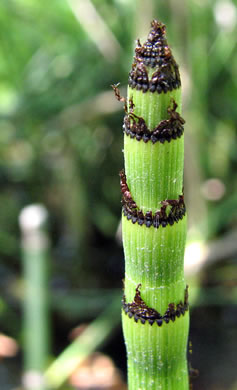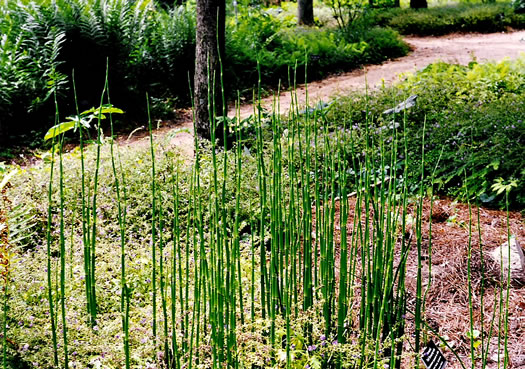Hovering over an image will enlarge it and point out features (works better on desktop than on mobile).
![]() A camera indicates there are pictures.
A camera indicates there are pictures.
![]() A speaker indicates that a botanical name is pronounced.
A speaker indicates that a botanical name is pronounced.
![]() A plus sign after a Latin name indicates that the species is further divided into varieties or subspecies.
A plus sign after a Latin name indicates that the species is further divided into varieties or subspecies.
Most habitat and range descriptions were obtained from Weakley's Flora.
Your search found 2 taxa in the family Equisetaceae, Horsetail family, as understood by Weakley's Flora.

![]()
![]() Common Name:
Field Horsetail, Bottlebrush Horsetail
Common Name:
Field Horsetail, Bottlebrush Horsetail
Weakley's Flora: (4/24/22) Equisetum arvense FAMILY: Equisetaceae
SYNONYMOUS WITH PLANTS National Database: Equisetum arvense FAMILY: Equisetaceae
SYNONYMOUS WITH Vascular Flora of the Carolinas (Radford, Ahles, & Bell, 1968): Equisetum arvense 002-01-001 FAMILY: Equisetaceae
Habitat: Moist streambanks, bottomlands, moist disturbed sites, road banks, railroad banks
Common in NC Mountains, uncommon in NC Piedmont (rare elsewhere in GA-NC-SC)
Native to the Carolinas & Georgia

![]()
![]() Common Name:
Tall Scouring-rush, River Scouring-rush
Common Name:
Tall Scouring-rush, River Scouring-rush
Weakley's Flora: (4/24/22) Equisetum praealtum FAMILY: Equisetaceae
SYNONYMOUS WITH PLANTS National Database: Equisetum hyemale var. affine FAMILY: Equisetaceae
SYNONYMOUS WITH Vascular Flora of the Carolinas (Radford, Ahles, & Bell, 1968): Equisetum hyemale var. affine 002-01-002 FAMILY: Equisetaceae
Habitat: Riverbanks, alluvial floodplains
Uncommon (rare in Coastal Plain)
Native to the Carolinas & Georgia
Your search found 2 taxa. You are on page PAGE 1 out of 1 pages.





